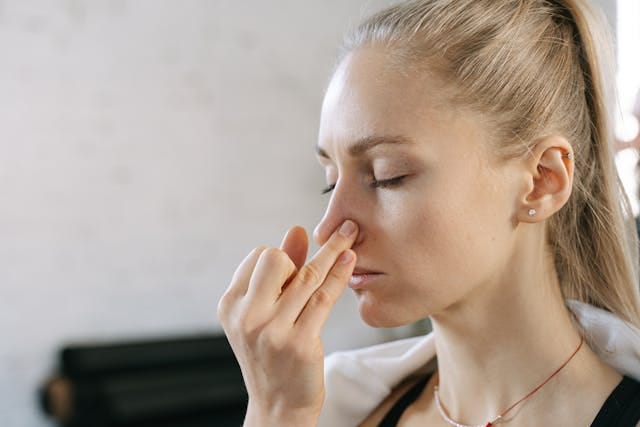Harnessing the Power of Breath Control to Conquer Anxiety and Stress
How intentional breathing can transform your mental and physical well-being
Anxiety disorders affect millions globally, with symptoms like restlessness, rapid heartbeat, and difficulty concentrating significantly impairing daily functioning. While conventional treatments such as medication can provide relief, they often come with unwanted side effects and fail to address the root causes. However, recent research highlights a simple, accessible, and natural solution: intentional breath control.
Breathing is more than a basic survival function—it directly impacts your mental and physical health. By learning to control your breath, you can tap into a powerful tool to manage anxiety and stress effectively. Let’s explore how and why this practice works, backed by compelling scientific evidence.
The Science of Slow Breathing: How It Calms Your Brain
A groundbreaking study conducted by neuroscientists at the Salk Institute has unveiled the neurological underpinnings of how slow breathing reduces anxiety. The researchers identified a brain circuit that connects the anterior cingulate cortex, pons, and medulla, which collectively regulate breathing and emotional states.
When this circuit is activated, it slows breathing and reduces anxiety. Conversely, when the circuit is suppressed, breathing quickens, and stress levels rise. This discovery provides a concrete explanation for why practices like yoga and mindfulness, which emphasise controlled breathing, have such profound calming effects.
The key takeaway? By consciously slowing your breath, you can directly influence this brain circuit to reduce anxiety and improve your emotional well-being.
The Role of the Body: How Anxiety Stiffens Your Torso
Anxiety doesn’t just affect your mind—it also manifests physically. One common response to stress is torso stiffness, where muscles in your upper body become rigid. This tension restricts blood flow back to your heart, reducing cardiac output and exacerbating symptoms like rapid heartbeat and shortness of breath.
A narrative review highlighted that aerobic exercise and proper breathing techniques can alleviate this issue. Aerobic activities like walking or swimming promote better circulation, while controlled breathing relaxes the torso muscles. Together, they improve oxygen and nutrient delivery to vital organs, breaking the cycle of physical tension and mental stress.
Four Breathing Techniques to Reduce Anxiety
Understanding the biomechanics of how your body and brain respond to stress is the first step. The next is incorporating simple yet effective breathing techniques into your daily routine.
1: Breathe Through Your Nose
Nasal breathing is essential for calming the nervous system. Unlike mouth breathing, which can over-oxygenate the body, nasal breathing filters and warms the air, regulates carbon dioxide levels, and promotes a sense of calm.
2: Adopt Horizontal Breathing
When stressed, many people take vertical breaths—lifting their chest with each inhale. This shallow breathing can activate the fight-or-flight response. Instead, focus on horizontal breathing, where you expand your ribcage sideways. This technique encourages relaxation by engaging your diaphragm and avoiding unnecessary stress activation.
3: Breathe Less, Not More
Rapid, deep breaths can actually increase anxiety by disrupting the balance of oxygen and carbon dioxide in your body. Aim to take slower, gentler breaths. This helps maintain optimal carbon dioxide levels, which calms your nervous system and lowers stress hormones like cortisol.
4: Practice Controlled Breathing Exercises
Incorporating specific exercises like alternate nostril breathing or the Buteyko method can retrain your brain’s response to stress. These methods emphasise slow, deliberate breathing, activating the parasympathetic nervous system—responsible for relaxation and recovery.
Integrating Movement and Breath for Holistic Relief
Combining controlled breathing with physical activity amplifies its benefits. Aerobic exercises such as running, cycling, or swimming increase heart rate and loosen tight muscles, including those in the torso. This improved flexibility and blood flow not only reduce anxiety but also enhance cardiovascular health.
Controlled breathing further complements these effects by activating your parasympathetic nervous system. This dual approach supports stress resilience, improves heart rate variability (a key indicator of stress adaptation), and fosters overall mental and physical wellbeing.
Why Breath Control Works: The Bigger Picture
The connection between breath and mental health has been a cornerstone of traditional practices like yoga and meditation for centuries. Now, science provides the evidence to back up these ancient teachings.
Neurological Benefits: The cortex-pons-medulla circuit demonstrates how conscious breathing influences the brain’s emotional centres.
Physical Benefits: Proper breathing relaxes torso muscles, improves circulation, and prevents the negative effects of anxiety on the cardiopulmonary system.
Holistic Approach: By addressing both the neurological and physical aspects of anxiety, breath control offers a comprehensive solution that goes beyond symptom management.
Take Control of Your Anxiety, One Breath at a Time
Anxiety can feel overwhelming, but the simple act of intentional breathing gives you a powerful tool to take control of your mental and physical state. Start by incorporating the techniques outlined above into your daily routine.
Remember, the path to better mental health doesn’t always require complex interventions. Sometimes, the solution lies in something as fundamental as your breath—a tool you’ve had all along.
Take a deep breath. Your journey to greater calm and resilience begins here.
About Doc Nic – Integrative Brain Wellness
Doc Nic is dedicated to empowering individuals with evidence-based strategies to improve mental health and overall wellbeing. By integrating neuroscience, holistic practices, and lifestyle changes, Doc Nic helps clients unlock their full potential and live balanced, fulfilling lives. His mission is to help transform lives one mind at a time.



